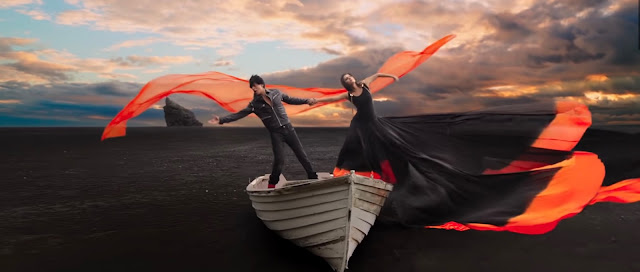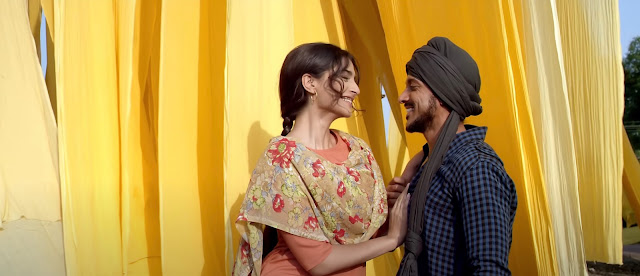
A few days ago, the song Kesariya from the upcoming Ayan Mukerji film Brahmastra was released, causing quite a kerfuffle all over social media. While Arijit Singh's rendition has been praised, the Hinglish phrase 'love storiyaan' has prompted many a discussion on the song. The song lyrics are about a lover talking about the beauty of his beloved. He adds, "Kesariya tera ishq hai, Piya, rang jaaun toh haath lagaun." He says that the color of his beloved's love is saffron. When he touches it, he becomes colored with it. Kesariya takes its meaning from the word kesar, the Hindustani name for saffron, a crop grown in Kashmir.

Love has always been associated with colors in Hindi cinema for ages. The music and lyrics from the films have reiterated that love evokes a feeling of being colored. Kesariya is not the only song that describes love as saffron. In Shah Rukh Khan and Kajol-starrer Dilwale, love was called ochre, which is quite close to saffron. In the track Gerua, the lover says to his beloved, "Duniya bhula ke tumse mila hun, nikli hai dil se ye dua, rang de tu mohe gerua." He has met her after forgetting the world, and the wish that has come out of his heart is that she colors him in the color of love which is ochre.
Gerua means Ochre or Orange to keep it simple…even a bit saffrony. So colour me in the colour of love. pic.twitter.com/9N0HTH4niz
— Shah Rukh Khan (@iamsrk) November 18, 2015

In the title song from Rang De Basanti, the color of love for the motherland is also saffron. Aur mohe tu rang de basanti yaara. This particular phrase Rang De Basanti has its roots in the song Rang De Basanti Chola, which was scripted by Ram Prasad 'Bismil' along with eighteen of his friends while fighting for freedom of India from the Britishers. Saffron is also the first color of the national flag.

Apart from saffron, love has been described in other colors. In Bajirao Mastani, Raja Chhatrasaal (Benjamin Gilani) honors Bajirao (Ranveer Singh) for protecting his kingdom from the enemy on the occasion of Holi. His warrior daughter Mastani (Deepika Padukone) performs a dance on Mohe Rang Do Laal, paying tribute to Mohe Panghat Pe from Mughal-E-Azam. The song is from the viewpoint of Radha, who asks Krishna to paint her red—the color of love, the color of vermilion. With all her hands lined in red color, Mastani gestures to Bajirao to put vermilion in her head, as if asking him to marry her. In the other half of the song, she says she is colored in green, the same color as that Krishna. Main to rangi hari Hari ke rang. Mastani, thus, feels the color of love as both red and green. Mohe Rang Do Laa is a lovely song with beautiful lyrics. It has two interesting lines. Laal is used once for Krishna (son of Nand) and once for the color red. Mohe rang do laal, Nand ke laal laal. Likewise, hari is used once for Krishna and once for the color green. Main to rangi hari Hari ke rang.

Sanjay Leela Bhansali used red and green as the color of love in his earlier films, too. In Devdas, Chandramukhi (Madhuri Dixit) experiences love in the color green. "Hum pe yeh kisne hara rang daala, khushi ne hamari humein maar dala," she sings. Who has thrown this green on me? My joy is killing me. In Goliyon Ki Raasleela Ram-Leela, love is the color red. Ram (Ranveer Singh) and Leela (Deepika Padukone) are colored in the hues of Laal Ishq. Yeh laal ishq, yeh malaal ishq.

In Shuddh Desi Romance, love is pink. In the stunningly shot Gulabi, the song lyrics say that love is gulabi. Jaane re jaane sab jaane hai, rang, rang gulabi hai preet toh. Everyone knows that pink is the color of love. The song is also shot in the pink city of Jaipur, and everything else in the song is pink.

In Kalank, love is symbolically compared with black. Kalank nahi, ishq hai kaajal piya. Love is not a blemish; instead, it is the kohl that helps accentuates one's beauty. The lead characters—Roop (Alia Bhat) and Zafar (Varun Dhawan)—also wear kohl in the film. And the walls of Bahaar Begum's (Madhuri Dixit) kotha are also made of black pillars. In Qurbaan, love is white. In the song Rasiya from the film, the singer says, "Saawali si saansein mori araj sunaave, aake more shwet preet pe rang saja de." Her dark-colored breaths request her lover to come and color her white-colored love.


Manmarziyaan treated love in shades of grey. It is not black or white, but grey, it says in the song Grey Walaa Shade. "Zamaana hai badla, mohabbat bhi badli, ghise pitey version nu, maaro update," it said. The world has changed, and so has love, and now, it is time to update the old versions. The Kanika Dhillon-written film portrayed a contemporary outlook on love and relationships in the age of Tinder.

In Kabhi Alvida Naa Kehna, there is not any song that describes the color of love; however, when Dev (Shah Rukh Khan) falls in love with Maya (Rani Mukerji), he invokes the color blue. "I like blue," he says. Then, moments later, right before the song Tumhi Dekho Na, Maya replies to him that she, too, likes blue. And then everything around them becomes blue. In Aiyyaa, Meenakshi's (Rani Mukerji) color of love for Surya (Prithviraj) is also blue. Likewise, in Rab Ne Bana Di Jodi, the color of love for Surinder Sahni (Shah Rukh Khan) is yellow. His car is yellow, and his lunchbox is yellow. Many other items in his house are yellow. And then, in the song Haule Haule, everything turns yellow.


There have been many other songs that talk about being colored by love without explicitly mentioning the color. In Prem Pujari, Suman (Waheeda Rahman) sings for Ram (Dev Anand), "Rangeela re, tere rang mein yun ranga hai mera mann." Oh, the joyous one, my heart has been stained in your color. In Maine Pyar Kiya, Prem (Salman Khan) addresses his lover Suman (Bhagyashree) as someone who is colored in his colors, "Mere rang mein rangne waali." In Kabhi Khushi Kabhie Gham, Anjali (Kajol) tells Rahul (Shah Rukh Khan) in Suraj Hua Maddham, "Tere hi rang se yun mein to rangi hoon sanam." In Goliyon Ki Raasleela Ram-Leela, Leela (Deepika Padukone) sings in Ang Laga De, "Ang laga de re, mohe rang laga de re." Touch your body with mine, color me. In Thakshak, Suman (Tabu) sings, "Mujhe rang de, ha rang de ha rang de, haan apni preet vich rang de."


In O Rangrez from Bhaag Milkha Bhaag, Milkha (Farhan Akhtar) sings, "Apne hi rang mein, mujh ko rang de, dheeme dheeme rang mein, mujh ko rang de." In Sun Saathiya from Any Body Can Dance 2, Vinnie (Shraddha Kapoor) performs a dance and says, "Barsa de ishqa ki syahiyaan. Rang jaaun, rang rang jaaun." In Fitoor, the color of Firdaus' (Katrina Kaif) deep red hair symbolized love and passion. The song Rangaa Re in the film talked lover getting dissolved in the soul like a color. "Main rang ban ke pighli hoon tere saath. O dil ranga re, tere rang ranga re, teri rooh mein main ghul gayi." Becoming a color, she has melted alongside her lover. Her heart is colored in your colors, and she is dissolved in his soul.


In the recent Atrangi Re, there was the song Tere Rang, whose lyrics are again based on Radha-Krishna's story and talk about being merged with the color of the lover. It is the time of Holi, and everyone is playing with colors. The woman (Sara Ali Khan) wants to meet her lover (Akshay Kumar), but she avoids getting colored by anyone else. She stops the kids. She stops her family members. She stops the people on the streets. The only person she allows to put color on her is her lover. "Tere rang ranga, mann mehkega," she adds.

There have been other many songs in this theme where the feeling of love brings color to the life of lovers. However, I keep returning to the glorious Satrangi Re from Dil Se, which added a new layer to this theme. It beautifully ties the seven stages of love defined in Arabic literature to the seven colors of the rainbow. The seven stages of love are hub (attraction), uns (infatuation), ishq (love), akidat (trust/reverence), ibadat (worship), junoon (madness) followed by maut (death). And in the song, we actually see the seven colors of the rainbow—violet, indigo, blue, green, yellow, and orange. Love, after all, is like a rainbow that brings with it the many colors of life.

Other Reading:
1. On Satrangi Re—The Seven Stages of Love—Link
Dialogue of the Day:
"Kesariya tera ishq hai, Piya, rang jaaun toh haath lagaun."
—Kesariya, Brahmastra

LOVED reading this! I'm sure you had to hold yourself back from making the post much longer, so many gems using colour.
ReplyDeleteThank you so much for reading. :)
DeleteThis is so lovely! Gulzaar's Saathiyaa also comes to mind.
ReplyDeleteThank you so much. :) I did not add that one as I already wrote it here:
Deletehttps://dichotomy-of-irony.blogspot.com/2015/10/saathiyaof-zulf-ke-neeche-gardan-pe-and.html